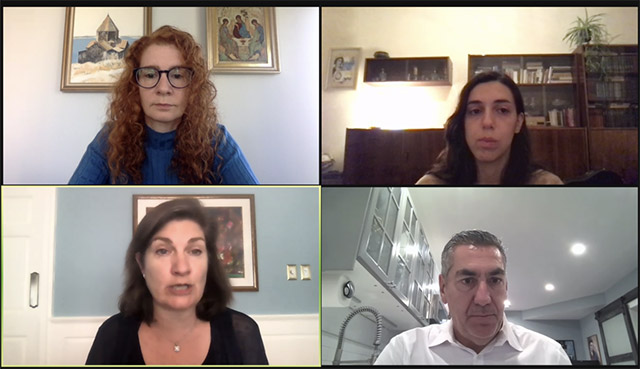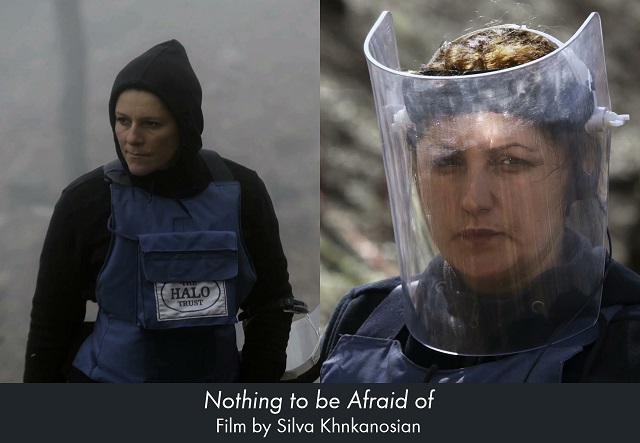Assembly’s Fall Advocacy Conference Concludes with “Media Matters” Panel
Assembly Communications Director Taleen Babayan, journalist Lilit Markosian, strategic communications advisor Arda Haratunian, and public relations commentator Peter Mirijanian
Washington, D.C. – The final panel discussion of the Armenian Assembly of America’s (Assembly) 2021 Fall Advocacy Week focused on “Media Matters,” which endeavored to evaluate the mainstream media’s coverage of the 44-day war on Artsakh, launched on September 27, 2020 by Azerbaijan, with the full and open support of Turkey. Featured panelists included Peter Mirijanian, founder of Peter Mirijanian Public Affairs, Arda Haratunian, a strategic communications advisor, and Lilit Markosian, a journalist based in Yerevan and New York City. Assembly Communications Director Taleen Babayan served as the moderator.
The panelists responded to a range of questions with in-depth insight, from gaining better access to editors and writers, to generating balanced and fair reporting in the media, and from highlighting newsworthy issues such as Armenian POWs, to taking concrete action steps.
Read also
One challenge in terms of coverage has been the decline of foreign news bureaus and correspondents, according to Haratunian, which can contribute to the lack of timely and accurate reporting.
“Fewer foreign correspondents are covering more countries, conflicts and stories and, in some cases, with less regional or historical expertise,” said Haratunian. “Armenians are fighting a media war largely punching at ghosts, with fewer people paying attention to it.”
It’s also incumbent upon the Armenian American community to provide proper context to journalists and publications to “move the ball forward here in the U.S.,” said Mirijanian, who noted the need to create opportunities to speak with editors and reporters about Armenia and Artsakh year-round, and not just during a time of conflict.
Haratunian said it’s important for Armenians to “maintain the staying power” after a crisis, and to focus on more universal stories that humanize the Armenian people and their plight. She stressed the need for better “coordination and collaboration among Armenians” in terms of connecting with journalists and media organizations, even on background, even during times when Armenia or Artsakh isn’t in the news.
“We have the truth on our side,” said Haratunian. “And that truth has to be shared patiently and methodically.”
Regarding the coverage of independent journalists who reported from Artsakh during the war, Markosian stated that these individuals “put themselves at great personal risk to capture and produce stories,” but ultimately did not have the same platforms to widely air their reports, as opposed to the mainstream media.
Social media also served as a resource during the war, although the conversations were not enough to fill the gaps of coverage. Markosian said that currently there are few journalists going to Artsakh, as it is bureaucratically difficult to gain access.
All three panelists honed in on the importance of framing a clear narrative moving forward.
“Sometimes we, as a community, take for granted the role that Armenians have played in this country [the U.S.], and also the context of the Armenian Genocide, and do not properly present our narrative to the mainstream media,” said Mirijanian, who emphasized the importance and effectiveness of grassroots advocacy in the diaspora through organizations like the Armenian Assembly of America.
While the Armenian Genocide was heavily covered by The New York Times, an early whistleblower at the time, there was a disparity in coverage during the 2020 war on Artsakh. Western media played a major role in exposing and explaining the Armenian Genocide, while seemingly being manipulated by Turkey and Azerbaijan last year, even as a genocidal situation threatened the Armenian people of Artsakh.
“The players involved and their values made the difference during the previous century when the Armenian Genocide was covered by The New York Times,” said Haratunian.
Haratunian added that she consistently conveys the point that “Armenia is one of the most solid young democracies” among the former Soviet republics and across that region when she communicates with editors and journalists.
Markosian, who recently published a piece in The Columbia Journalism Review about coverage of the war on Artsakh, said she found it challenging to fact-check and often needed to double and triple-check sources because of the lack of fair and accurate reporting and basic awareness about the region.
“The reality is that a lot of journalists are overworked, underpaid, and don’t have the resources to get into it,” said Markosian. “It is difficult to get the facts right, even if you’re an Armenian in Armenia and doing research.”
In terms of concrete steps that the Armenian community can make collectively, Haratunian suggested being alert on social media and to “actively engage, but in a positive way, such as sending corrections and sharing accurate links.”
She also encouraged pitching stories to media outlets from a humanitarian perspective, including impactful war stories and soldiers’ stories, as well as overall positive news about Armenia, such as successes in its tech and tourism sectors.
Markosian capped the discussion by emphasizing the imperative to “critically examine our narrative, yet find a way to be presentable to the international media.”
In closing, Mirijanian said that educating journalists and the media by deploying a common narrative should be an ongoing responsibility for Armenians in the homeland and across the diaspora.






















































